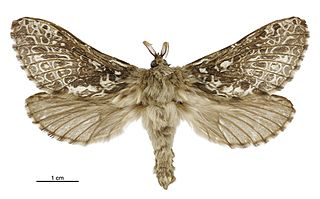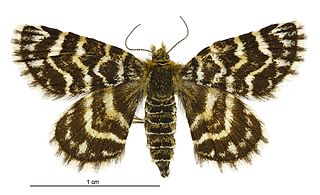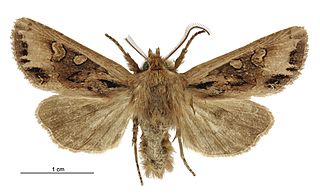
The Hepialidae are a family of insects in the lepidopteran order. Moths of this family are often referred to as swift moths or ghost moths.

Sabatinca heighwayi is a species of moth belonging to the family Micropterigidae. It was described by Alfred Philpott in 1927 and is endemic to New Zealand. It can be found north of Lewis Pass in the north west of the South Island. Adult moths are on the wing from late September until the middle of January. The host of the larvae of this species is the foliose liverwort Plagiochila circumcincta.

Aoraia aurimaculata is a species of moth of the family Hepialidae. It was described by Alfred Philpott in 1914 from a specimen collected at The Hermitage, Mount Cook by F. S. Oliver. This holotype specimen is now lost. A. aurimaculata is endemic to New Zealand, where it is found along the Southern Alps and western Fiordland in cool temperate to subalpine forests and lower penalpine shrubland.

Aoraia enysii, also known as the forest ghost moth is a species of moth of the family Hepialidae. It is endemic to New Zealand. This is the only species of the genus Aoraia that can be found in the North as well as the South Island. This species can be found from Mount Te Aroha southwards. This species was described by Arthur Gardiner Butler in 1877 from a specimen obtained in the North Island by J. D. Enys.

Aoraia senex is a species of moth of the family Hepialidae. It is endemic to New Zealand, where it is known from the South Island. This species was first described by George Vernon Hudson in 1908 from specimens discovered by J. H. Lewis in Central Otago.

Dioxycanus oreas is a species of moth of the family Hepialidae. It is endemic to New Zealand. It was first described by George Vernon Hudson in 1920. The species was discovered by Averil Lysaght.

Dumbletonius unimaculata is a species of moth of the family Hepialidae. It is endemic to New Zealand. This species is host to the vegetable caterpillar fungus Ophiocordyceps robertsii.

Mnesarchaea fallax is a species of primitive moth in the family Mnesarchaeidae. It is endemic to New Zealand. This species is found in the Taranaki, Taupo, Nelson and Buller regions. It lives in a variety of habitats such as beech forest clearings, native podocarp forest, red tussock grasslands as well as in flax wetlands and at higher altitudes of up to 1300m. Much of the life history of this species is unknown and as at 2021 the host plants of this species have yet to be confirmed. The adult moths are on the wing from October to December. This species is classified as "Not Threatened" by the Department of Conservation.

Mnesarchaea fusca is a species of primitive moths in the family Mnesarchaeidae. This species was first described by Alfred Philpott in 1922, and is endemic to New Zealand. The larvae of the species is bright green when young but turns a brownish green when mature. Adults of this species are small and dark brown with patches of reddish yellow on its forewings. This species is found in Nelson and Marlborough Sounds. It inhabits poorly lit forest ravines and gullies or areas near shaded waterways. Adults are on the wing between December to February.

Wiseana copularis is a species of moth belonging to the family Hepialidae. It is endemic to New Zealand. This moth is one of several very similar looking species within the genus Wiseana and this group are collectively referred to as "Porina" moths. In its larvae form this species consumes pasture grasses and, if numerous, is regarded as a pest by New Zealand farmers reliant on good quality pasture for their stock.

Wiseana mimica is a species of moth belonging to the family Hepialidae. It was described by Philpott in 1923, and is endemic to New Zealand.
Glyphipterix necopina is a species of sedge moth in the genus Glyphipterix. It is endemic to New Zealand. It is classified as Not Threatened by the Department of Conservation.

Locheutis fusca is a moth of the family Oecophoridae. This species was discovered on 16 January 1930 by Alfred Philpott in the Tongariro National Park. L. fusca was described by him later in that same year. It is endemic to New Zealand.

Archyala opulenta is a species of moth of the family Tineidae. This species is endemic to New Zealand has been found in the upper Maitai Valley in Nelson as well as in Northland. The larvae of this species are associated with endemic bat species as they feed on the guano of Mystacinidae. The adult moths are on the wing in November. It is classified as "Data Deficient" under the New Zealand Threat Classification System by the Department of Conservation.

Orocrambus scoparioides is a moth in the family Crambidae. It was described by Alfred Philpott in 1914. It is endemic to New Zealand, where it has been recorded in the mountain ranges of Otago and Southland.

Pseudocoremia lutea is a species of moth in the family Geometridae. It is endemic to New Zealand. It is classified as "At Risk, Naturally Uncommon" by the Department of Conservation.

Asaphodes imperfecta is a moth in the family Geometridae. It is endemic to New Zealand and is found in the southern part of the South Island. The species inhabits low lying swampy native forest. The host plants of the larvae of this species is unknown. The adults are on the wing in December and January. It is classified as critically endangered by the Department of Conservation.

Cnephasia paterna is a species of moth in the family Tortricidae. It is endemic to New Zealand. This species is classified as Nationally Endangered by the Department of Conservation.

Notoreas hexaleuca is a species of moth in the family Geometridae. This species is endemic to New Zealand.

Ichneutica fenwicki is a moth of the family Noctuidae. This species is endemic to New Zealand and is found in the southern parts of the South Island and on Stewart Island. It is a distinctively coloured moth that is unlikely to be confused with closely related species. It is a spring flying moth being on the wing from September to November. The life history and host species of the larvae of I. fenwicki are unknown.



















